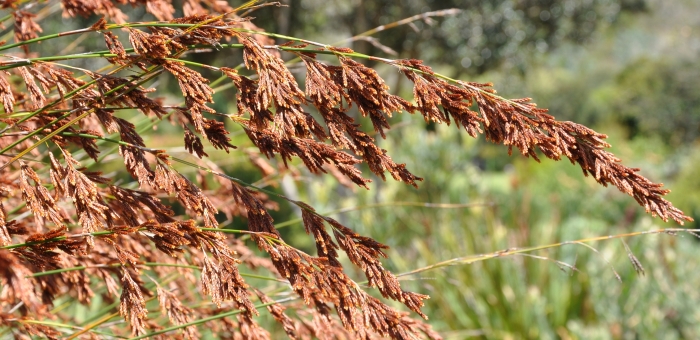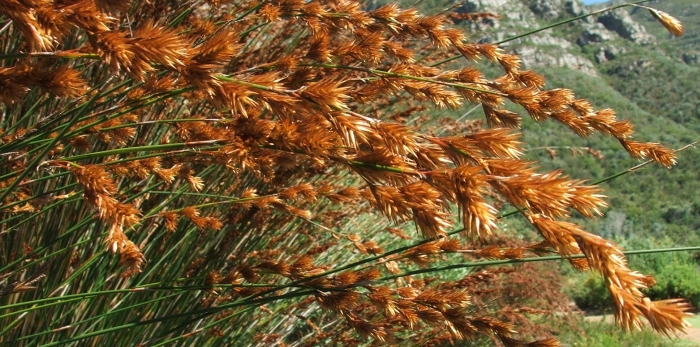Thamnochortus insignis
Thamnochortus insignis Mast.
Family: Restionaceae
Common names: Albertinia thatching reed (Eng.); dekriet, mannetjiesriet (Afr.)
Introduction
A stunning accent plant with its slender stems tipped with small, golden-brown inflorescences in late summer, and water-wise too!

Description
Description
Thamnochortus insignis plants are tall, reed-like tussocks with a diameter of 500 mm to 1 m at the base and a spread of 3 m or more at the top and up to 2.5 m tall. Male and female plants are separate and very similar when they are not flowering.

Thamnochortus insignis flowers in midsummer (January-February) and produces large amounts of seed in autumn (April-May). The plants are at their most ornamental from about 2 months before flowering to a few months after producing seed.
The seed comes in the form of a tiny nutlet inside the old flower, which by this stage has formed two small wings. This helps the wind to disperse the seeds. The seeds are produced in very large quantities by each female plant, but are not all viable; a large number of nutlets are empty. Why the plants expend all this energy to produce sterile seeds is not clear, but is particular to this genus as well as to the genus Elegia.
Conservation Status
Status
Thamnochortus insignis has a stable wild population and is not threatened. It is assessed as Least Concern (LC) on the Red List of South African Plants.
Distribution and habitat
Distribution description
Thamnochortus insignis grows in dense stands in alkaline and acid coastal sands in the southern Cape, from Agulhas to Gouritsmond and is common around Albertinia.
Since it has been grown commercially and trucked far and wide to be used for roofing, it can now be found along the roadsides from Port Elizabeth to the Cape Peninsula to the Cedarberg, because the seed has been distributed by the trucks carrying the thatching material. It is now naturalised between the Cape Peninsula and Cape St Francis.
Derivation of name and historical aspects
History
The genus name Thamnochortus, means ‘bushy grass', derived from the Greek thamno- meaning ‘bush’ and chortus, ‘green herbage'. The species name is Latin and means ‘remarkable’.
Plants of the Restionaceae family, commonly called restios, occur mainly in the Southern Hemisphere, and are found in South America, Africa, Australia and New Zealand. In Africa there are about 330 species, most of which can be found in the fynbos of the Cape Floristic Region.

Ecology
Ecology
The plants are wind-pollinated with the male inflorescences in small tassels swaying in the wind, while the female flowers are at the base of medium-sized bracts, which catch the pollen from the air and funnel it towards the small fringed styles of the female flowers. The male flowers produce pollen in such large amounts that bees come and collect the pollen to use in the beehives and during a still day the droning of the bees around the plant can be heard clearly.

Uses
Use
Although there are a number of other restio species with tall, straight culms that have been used for thatching in the past, and are still used occasionally in rural areas, it is only Thamnochortus insignis that is cultivated on a large commercial scale. The plants are long-lived and culms can be harvested every five years; and, depending on the weather conditions, a well-thatched roof can last for about 30 years on the coast and up to 70 years in dry areas like the Karoo.

For more about thatching and restios see two articles from Veld & Flora:
On restios and roofs by Dr J Rourke (1974) and The thatching reed of Albertinia by H P Linder (1990).

Growing Thamnochortus insignis
Grow
Propagation is from seed. Before sowing, the seed should be treated with smoke or soaked in a smoke-water solution. The seed should be sown during early autumn, when the nights are cool, between 10°C and 15°C, and the days are still warm, between 20°C and 30°C. After about three weeks the seed germinates and after another six to nine weeks can be pricked out.
Thamnochortus insignis occupies a relatively large space and in a large garden it can be a beautiful accent plant. In a fynbosor water-wise garden these plants can form the backbone of the garden, in between the much shorter-lived proteas and ericas. The plants prefer a deep, slightly acidic sandy soil but adapt readily to normal garden conditions as long as the soil is well-drained. In garden situations the plants should be planted in a sunny position with good air circulation; do not plant very close to a wall.
During the first three months after planting the plants should be watered regularly; once they are growing well they need very little water. When planted in a situation to their liking, the plants will stay very healthy and attract no pests or diseases.
The first culms are small, finely divided and curly looking. The tall, single culms only appear when the seedlings are nearly a year old. When the plants are three years old they start to bulk up.
References
- Jackson, W.P.U. 1990. Origins and meanings of names of South African plant genera. University of Cape Town.
- Manning, J. & Goldblatt, P. 2012. Plants of the Greater Cape Floristic Region 1: the Core Cape Flora. Strelitzia 29. South African National Biodiversity Institute, Pretoria.
- Raimondo, D. et al. 2009. Red list of South African plants. Strelitzia 25. SANBI (South African National Biodiversity Institute), Pretoria.
Credits
Hanneke Jamieson
Kirstenbosch National Botanical Garden.
April 2001
updated October 2018
Plant Attributes:
Plant Type: Restio
SA Distribution: Western Cape
Soil type: Sandy, Loam
Flowering season: Late Summer
PH: Acid, Neutral
Flower colour: Brown, Yellow
Aspect: Full Sun
Gardening skill: Easy
Special Features:
Horticultural zones









Rate this article
Article well written and informative
Rate this plant
Is this an interesting plant?
Login to add your Comment
Back to topNot registered yet? Click here to register.